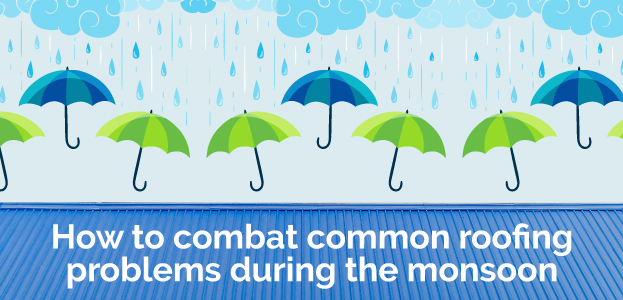
How to combat common roofing problems during the monsoon
October 01st, 2018
Category: All Blogs, Maintaining your roof
The monsoon season and while the Indian rains are a welcome relief from the sweltering heat of summer, they also come with humidity, flooding, seeping, blockages and a host of other problems. It doesn’t just affect our roads but our homes too sometimes. Your roof is your home’s first defence against the elements. Monsoon storms are accompanied by heavy rains and gusts of winds, both of which can cause significant damage to your roof. Should rainwater or moisture make it past your roofing material, both would leave your home’s ceiling and walls susceptible to damage. Here are some common roofing problems and solutions to ensure your roof and home stay safe this monsoon season.
Inspect your roof for leaks:
The most pressing problem when it comes to roofing is leaks. There are various reasons for a leak to start. It could be poor roof designing. If your roof doesn’t have the proper drainage in place or is too flat, water could stagnate and over time will penetrate your roofing material and into your home. To avoid leaks, ensure you inspect your roof periodically and never neglect maintenance.
Use a tarp:
This is one the quickest and most effective ways to fix a leak in your roof. Cover the area with plastic tarp to prevent more water from seeping into your home. This should offer sufficient protection during the monsoon until your roofing contractor gives it a proper repair.
Look for and re-adhere missing shingles:
While inspecting your roof, be on the lookout for missing shingles. These pose more of a threat to your home as they open up a larger area to the heavy rains and wind. A single missing shingle is enough for a gust of heavy wind to blow a significant portion of your roof off. Nail down loose shingles or glue them down with roofing cement if you have access to it. Alternatively, you could also make use of copper or sheet metal. This can be done in case of missing shingles. All you need to do is cut out the right shape and then simply nail or glue it on to your roof in the place of the missing shingle.
Consider waterproofing:
If your roof has never been waterproofed or you’re thinking of adding a new layer, then it’s best to get it done before the monsoon starts. It’s crucial that your home and roof have an added layer of protection during these months, when your home is at its highest risk of being damaged.
There are several types of waterproof coating available in the market based on the kind of roofing material in use. Ensure you apply a thick, even layer across your roof, to prevent any leaks or damage.
Clean rain gutters:
Before the onset of the monsoon months, check your drainage system and gutters to make sure they aren’t clogged with dirt and debris. If they aren’t cleared, clogged drains can lead to stagnant water, which could potentially seep into your home. Clogged rains also mean rainwater will overflow, either spreading into your home or its surroundings. This becomes a concern if there are electrical conduits nearby, which will short-circuit when flooded by water. If you live in an area that experiences heavy rainfall, be sure to check your drainage systems and gutters from time to time. These roofing tips and tricks will help you in the long run.
Choose the right roofing material:
When looking for roofing tips and tricks, choosing the right material should top your list. If you’re thinking of updating your roof or building a new home, choosing the right type of roof and materials can save you money and expenses in the long term. While there are several types of roofing materials to choose from, metal roofing sheets, particularly galvanised metal sheets are the most effective against extreme weather conditions and elements. Dura Roof’s metal roofing sheets come in the form of shingles and panels and the materials range from zinc, aluminium and steel.
Do not renovate during the monsoon!
Avoid renovating your home or roof during the monsoon season at all costs. Be it painting, maintenance, waterproofing, etc., ensure you start your work and complete everything well ahead of the monsoons. Any renovation or maintenance work takes time. In the likely event of a sudden shower, your home will be left susceptible to damage if your roof is not in top shape.
The monsoons cannot be avoided, but with the right preparation, you can ensure your roof stays in the best condition through the storms. Head over to Dura Roof for top-quality roofing solutions to withstand all seasons!
Leave a Comment

1 Response received for this post